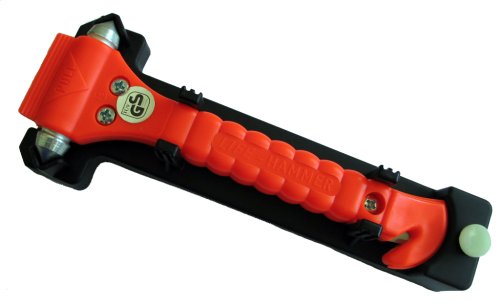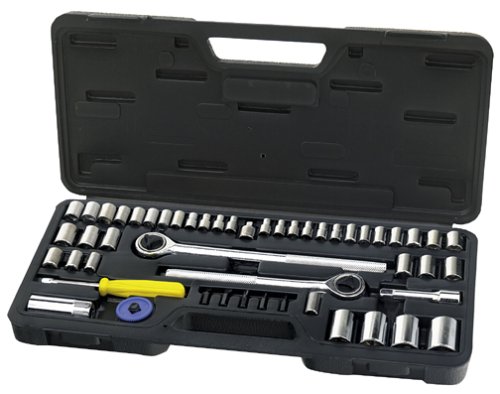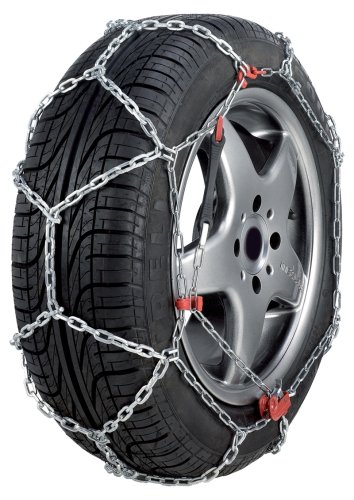When you're on the road, you're out in the world, and the world can get dangerous when you least expect it--especially if your car breaks down or runs into trouble. So what can you do about it? You're (probably) not a mechanic, after all.
Fortunately, you don't have to be a mechanic to give yourself a much better chance of getting home or to the nearest repair shop with a small kit of essential tools and equipment--and in the event of an accident or other emergency, you'll even increase your odds of survival.
This short list of items encapsulates some of the most functional and likely items you'll need, while requiring minimal mechanical or other knowledge to employ. They're the basics. You could load your car up with dozens of other tools, of course, but you could also do a lot worse than keeping these nine inexpensive core items with you at all times.
(Note: The items linked are merely offered as examples; there are many options within each item category, varying in quality, price, and application.)

LifeHammer emergency tool. Image via Amazon.com.
LifeHammer or other window/seatbelt escape device
This small item could be a lifesaver--literally. Kept near the driver's seat via velcro or double-sided tape, it can allow you to break a window if you end up underwater or otherwise trapped in your car, and can also cut the seatbelt (a notoriously tough bit of fabric, for obvious reasons) quickly. Time is of the essence when you're short on air, the car is on fire, or other danger looms. Getting out quickly is made that much easier with this cheap and simple tool.

Socket set. Image via Amazon.com.
Socket & screwdriver set
Even on the most modern cars, sometimes things come loose, whether from vibration, age, or other reasons. Often, a simple tightening of whatever's loose will solve the problem. This can be especially helpful with a loose battery terminal connection, a slipped hose clamp, or other simple and obvious problems under the hood. Even if you aren't an automotive whiz, popping the hood and looking for obvious problems like these is easy--just put eyes on the major systems and scan for loose or disconnected sections.
Get a set with multiple socket sizes and screwdriver tips for the most flexibility, and be sure to familiarize yourself with how they go together before stowing the box in your trunk.

Duct tape. Image via Amazon.com.
This might sound a bit too simple, but duct tape can fix a myriad of ills. From damaged body work after a fender bender to temporary emergency fixes on hoses and other parts, duct tape can patch your car back together long enough to limp it to a repair shop and keep you from being stranded--or spending for a tow truck. It's also handy in a million other non-automotive situations. Be sure to get quality tape, as the more expensive stuff sticks better and in a wider range of temperatures and situations.

Tow strap. Image via Amazon.com.
This length of super-strong fabric can be used for a lot more than hauling your buddy's old truck from one weed-infested yard to another--though it's great for that too. With a tow strap, you can move an otherwise disabled car short to medium distances (think a few miles, rather than across town or to the next state) with nothing more than the help of a passing stranger in a pickup. If you're that stranger in a pickup, you can use it to offer the same help. But a tow strap's super-strong nature also makes it a good all-purpose length of tie-down or rescue rope, too.
Be sure to read your owner's manual to find the proper tie-down and tow points for your car before you add it to your stash. If you should need to use it, an improperly placed strap can quickly cause even more damage if it's attached to the wrong part of the car's structure.

Jumper cables. Image via Amazon.com.
A dead battery is frustrating, whatever the cause. Such a simple piece of equipment, and yet its failure can completely disable a car. Even if the battery itself can no longer hold a charge, a set of jumper cables can get you back on the road and to the nearest parts shop. Choose heavy-gauge cables with durable, high-quality spring-loaded clamps on each end rather than the smaller, cheaper sort. Avoid the kind that plugs into the cigarette lighter/cabin 12-volt outlet altogether. A proper set of jumper cables is more useful and will work with a wider array of cars and trucks.

Fixed-blade knife. Image via Amazon.com.
Sometimes it's not connections you need to make or re-secure, but things you need to separate or get rid of. That's where a knife comes in handy. Say you get a length of rope or other road debris wrapped around an axle, or a portion of your plastic bumper is broken in a fender-bender, but is rubbing against the tire, and can't be re-secured with duct tape--just cut off the offending part and get back on the road (and be sure to have the car checked out for other, less-visible problems afterward).
The knife, like many other items in this kit, can also help if you do end up stranded somewhere. It's one of the most basic tools in the human experience, and its uses can be literally endless, from opening food containers to cutting tinder for an emergency fire.
Be sure to get a knife that locks its blade in place securely if you opt for a folding knife (fixed blade knives can be even more useful due to their inherent strength)--you don't want the blade to collapse on your hand and make a bad situation even worse.

Tire inflator/sealer. Image via Amazon.com.
Many cars come with spare tires, but is your spare still inflated? Is it inflated to the proper pressure? What do you do if your spare tire fails? These are all problems that can be reduced or eliminated if you keep a can of tire inflator/sealer with you at all times. Each brand has its own specific instructions, but the basics are the same: hook it up to the tire's valve stem, and let the stuff inside the can go to work finding the tire's leak and filling it with enough pressure to let you drive to the nearest tire shop.
The sticky compound that does this magic isn't actually magical, however, and it shouldn't be relied on past one emergency use. Get the tire replaced at a reputable shop, and don't be surprised if you're hit with an extra fee to clean the dried inflator/sealer goop off the wheel, too.

Tire pressure gauge. Image via Amazon.com.
This is the one tool in the kit you should use the most often--weekly, at the least. Keeping tabs on the pressure in your tires can prevent underinflation-related blow-outs from happening in the first place, as well as maximizing your gas mileage and the life of the tires' tread. Buy a dial-faced gauge rather than the cheap stick-type ones. You'll spend $30 or so, but you'll have a much more accurate and reliable reading.
Pay special attention to tire pressure around the changes in seasons. Ambient temperature can have a surprisingly large impact on the air pressure in your tires--but you'd know that already if you check your tires pressures every week.
To keep from forgetting about it, try to set a routine. For example, make it a part of your Monday morning or Friday evening ritual. That way, you'll know where you're at and whether you're set for the coming week.
If you're headed out on a long trip, always check your tire pressures immediately before leaving. You don't want to get 100 miles from home before that slow leak turns into a flat tire, and extended highway cruising can make underinflation that might go unnoticed at city speeds a serious problem due to the heat buildup at higher speeds.

LED work light. Image via Amazon.com.
It's nice to think all your troubles on the road will happen on a bright, sunny day, but what if things go wrong at night? Your smartphone might work to get you from the bed to the bathroom, but you'll want a real flashlight if you have real work to do at night--or in less accessible areas of the car, even in daylight.
Find a flashlight that has a magnet on its side for easier hands-free use. Be sure to change the batteries regularly, and keep a set of spares in the car. You never know when you might need to have a continuous source of light for a few hours or even a full night.
Winter bonus items:
These might not be all that useful year-round, but depending on the climate of your home (or along your road-trip route), these can be life-savers--literally--in the winter.

Mylar blanket. Image via Amazon.com.
Mylar blanket and/or wool blanket
The mylar blanket relies on its excellent reflectivity to trap your body heat and keep you warm, so be sure to wrap it completely around you. Even for those not traveling in or through especially cold climates, the mylar can be helpful, as it also keeps the heat of the sun out, and can function as an emergency reflector if you need to signal someone from a distance.
A wool blanket (or other fabric blanket) is a great choice for its warmth-preserving properties, but it also can have many other uses. Bundled, it can serve as a pillow or other cushion. Cut into strips with your knife, it can serve as a bandage or sling. The uses are almost endless if you're creative--and necessity is, after all, the mother of invention.

Snow scraper/brush. Image via Amazon.com.
This one is obvious, but it's something many people forget, or leave at home in the garage. Getting the ice off your windows is a vital part of safe driving in the winter, and it's made all the easier with a purpose-built tool. Don't rely on your credit card or library ID.

Tire chains. Image via Amazon.com.
Whether your car is front-wheel drive, rear-wheel drive, or all-wheel drive, chains can get you out of a slippery situation when used properly. Be sure to read the instructions and your owner's manual for details on how--or if--you should use them.

Folding shovel. Image via Amazon.com.
Compact and often multi-faceted (some have hatchet functions or waterproof handle compartments to store items like matches), the folding shovel can be handy in many situations, too. For winter use, a shovel can dig you out of a roadside snow bank, clear a path for spinning wheels, and more.
